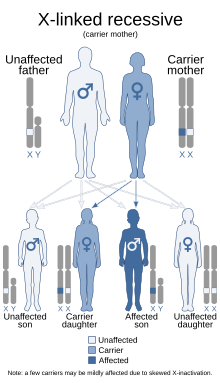| Brunner syndrome | |
|---|---|
| Other names | Monoamine oxidase A deficiency |
 | |
| This condition is inherited in an X-linked recessive manner. | |
Brunner syndrome is a rare genetic disorder associated with a mutation in the MAOA gene. It is characterized by lower than average IQ (typically about 85), problematic impulsive behavior (such as pyromania, hypersexuality and violence), sleep disorders and mood swings. It was identified in fourteen males from one family in 1993. It has since been discovered in additional families.
Signs and symptoms
The following signs and symptoms occur in people with monoamine oxidase A deficiency, which causes Brunner syndrome:
- lack of impulse control
- aggressive or violent outbursts
- ASD or ADHD-like behavioral features
- obsessive behaviors
- difficulties forming friendships
- problems focusing attention
- sleep problems
- trouble falling asleep
- night terrors
- skin flushing
- sweating
- headaches
- diarrhea
Causes
Brunner syndrome is caused by a monoamine oxidase A (MAOA) deficiency, which leads to an excess of monoamines in the brain, such as serotonin, dopamine, and norepinephrine (noradrenaline). In both mice and humans, a mutation was located on the eighth exon of the MAO-A gene, which created a dysfunctional MAO-A gene. The regular function of MAO-A, breaking down monoamines, is disrupted, and monoamines build up within the brain. Mice that lacked a functional MAO-A gene displayed higher levels of aggression, in comparison to mice with a functional MAO-A gene.
Diagnosis
No diagnostic method has been established yet.
Treatment
There is no restrictive treatment for Brunner syndrome, although a potential treatment can be established by checking the patient for signs and symptoms and analysing different catabolites in bodily fluids, that would be indicative of excess amount of monoamines in the body and mediating the symptoms by targeting therapy for the most problematic neurotransmitter. For example, if a patient is found having excess amount of serotonin in the blood (hyperserotonemia) and abnormal urine 5-HIAA levels then the patient might benefit from a serotonin reuptake inhibitor and dietary modifications.
History
Brunner Syndrome was described in 1993 by H.G. Brunner and his colleagues upon the discovery of a particular genetic defect in male members of a large Dutch family. Brunner found that all of the male family members with this defect reacted aggressively when angry, fearful, or frustrated. The defect discovered was later found to be a mutation in the gene that codes for monoamine oxidase A (MAOA gene). Brunner said that an "MAO-A deficiency is associated with a recognizable behavioural phenotype that included disturbed regulation of impulsive aggression".
A letter published by Hebebrand and Klug (1995) criticized Brunner's findings for not using strict DSM criteria.
Society and culture
Brunner's findings have been used to argue that genetics, rather than decision-making processes, can cause criminal activity. Evidence supporting the genetic defense stems from both Brunner's findings and a series of studies on mice. To prove the correlation between MAO-A deficiency and aggression in courts, it is often contended that individuals cannot be held accountable for their genes, and as a result, should not be held responsible for their dispositions and resulting actions.
References
- ^ Hunter P (September 2010). "The psycho gene". EMBO Rep. 11 (9): 667–9. doi:10.1038/embor.2010.122. PMC 2933872. PMID 20805840.
- Online Mendelian Inheritance in Man (OMIM): 300615
- Brunner HG; Nelen MR; van Zandvoort P; Abeling NGGM; van Gennip AH; Wolters EC; Kuiper MA; Ropers HH; van Oost BA (June 1993). "X-linked borderline mental retardation with prominent behavioral disturbance: phenotype, genetic localization, and evidence for disturbed monoamine metabolism". Am. J. Hum. Genet. 52 (6): 1032–9. PMC 1682278. PMID 8503438.
- Piton A, Redin C, Mandel JL (August 2013). "XLID-causing mutations and associated genes challenged in light of data from large-scale human exome sequencing". Am. J. Hum. Genet. 93 (2): 368–83. doi:10.1016/j.ajhg.2013.06.013. PMC 3738825. PMID 23871722.
- "Monoamine oxidase A deficiency". MedlinePlus. Retrieved 23 February 2023.
- ^ Brunner HG, Nelen M, Breakefield XO, Ropers HH, van Oost BA (October 1993). "Abnormal behavior associated with a point mutation in the structural gene for monoamine oxidase A". Science. 262 (5133): 578–80. Bibcode:1993Sci...262..578B. doi:10.1126/science.8211186. PMID 8211186.
- ^ Scott, AL; Bortolato, M; Chen, K; Shih, JC (2008-05-07). "Novel monoamine oxidase A knock out mice with human-like spontaneous mutation". NeuroReport. 19 (7): 739–43. doi:10.1097/WNR.0b013e3282fd6e88. PMC 3435113. PMID 18418249.
- Palmer, E. E.; Leffler, M.; Rogers, C.; Shaw, M.; Carroll, R.; Earl, J.; Cheung, N. W.; Champion, B.; Hu, H.; Haas, S. A.; Kalscheuer, V. M.; Gecz, J.; Field, M. (January 2016). "New insights into Brunner syndrome and potential for targeted therapy". Clinical Genetics. 89 (1): 120–127. doi:10.1111/cge.12589. hdl:11858/00-001M-0000-002D-479D-D. ISSN 1399-0004. PMID 25807999.
- Hebebrand J, Klug B (September 1995). "Specification of the phenotype required for men with monoamine oxidase type A deficiency". Hum. Genet. 96 (3): 372–6. doi:10.1007/BF00210430. PMID 7649563. S2CID 33294633.
- ^ Halwani S, Krupp DB (2004). "The genetic defence: the impact of genetics on the concept of criminal responsibility". Health Law J. 12: 35–70. PMID 16539076.
- ^ Baker LA, Bezdjian S, Raine A (2006). "Behavioral genetics: the science of antisocial behavior". Law Contemp Probl. 69 (1–2): 7–46. PMC 2174903. PMID 18176636.
External links
| Classification | D |
|---|---|
| External resources |
| X-linked disorders | |||||
|---|---|---|---|---|---|
|